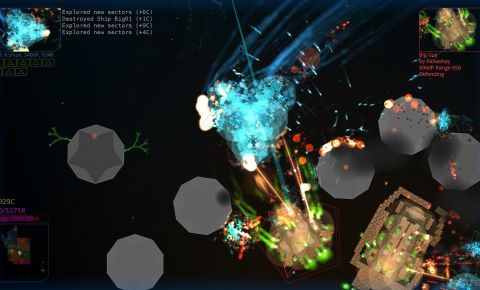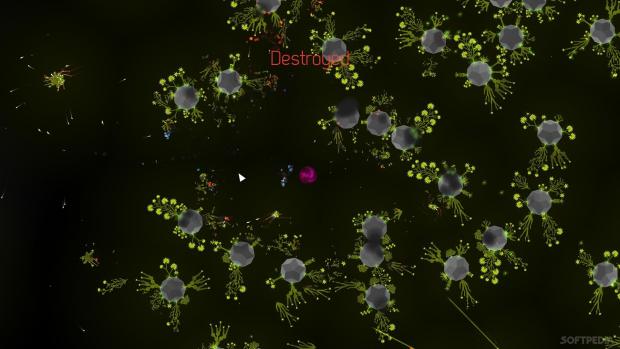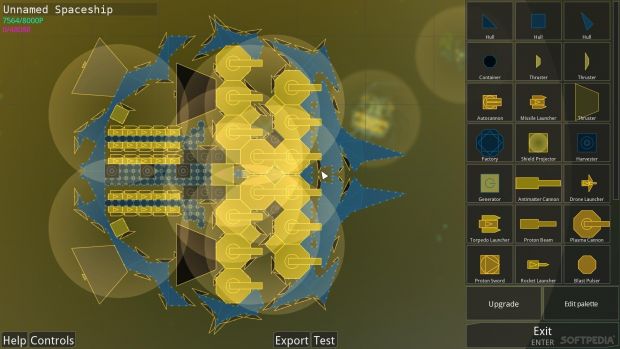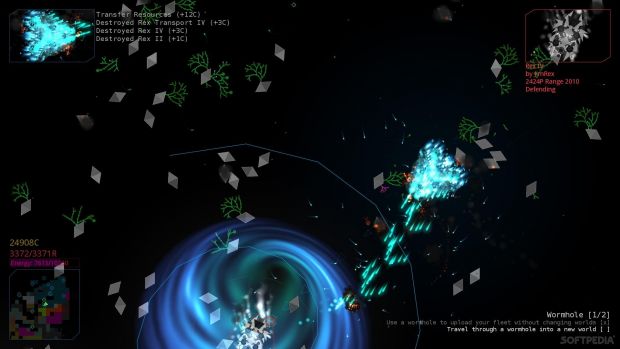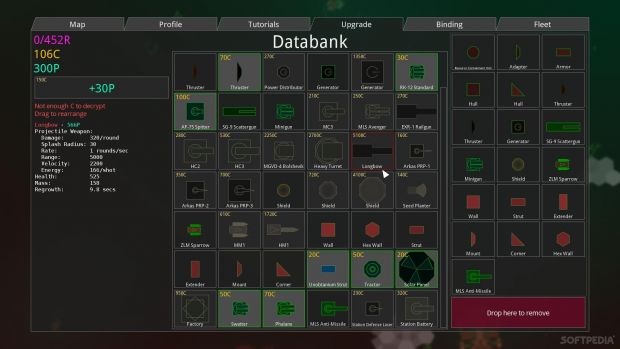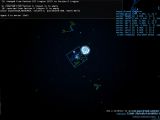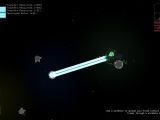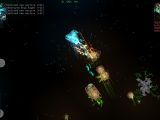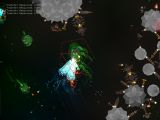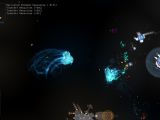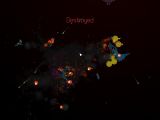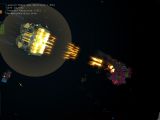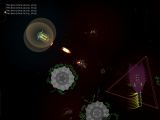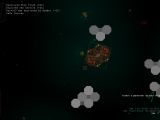Certain games have the potential to offer you more hours of fun with their ancillary game systems, rather than the main gameplay loop.
Anisoptera Games’ 2D space shooter Reassembly is one such title, as the ability to design your own ships goes far beyond everything that has been done in the genre.
At its most basic, it’s a bare-bones and straightforward shipbuilding sim that also lets you wreak havoc on a sector of space, or die trying and go back to the drawing board, only to have another go at it.
Quite simply, there’s a pretty big chance that you’ll end up spending more time building your ships than you will flying them, especially if you’re the tinkering type, because nothing is ever perfect, and there’s always something you can improve.
And the nicest thing about the whole situation is that whenever you think you’ve found the perfect looks / efficiency trade-off, you’re going to run into something that runs laps around you or shuts you down in one volley, and you’re going to laugh and build something different.
Gameplay
The first thing that piqued my interest was, understandably, the immense potential of the ship builder. I liked playing with Legos as a child and I still throw a cursory look in the direction of the Mobile Frame Zero hangar from time to time, so I find any game that offers you basic building blocks and freedom to be greatly appealing.
The next was the science fiction theme. As an avid consumer of the genre, I always take a look at games that take place in space. Unfortunately, Reassembly fails to offer a satisfying experience from this point of view.
There is no storyline, no fantasy universe, no context for your actions, which is a tad disappointing. You just exist, you build more and more ships, then you step through a wormhole and invade another galaxy sector that looks almost the same, rinse and repeat.
But in spite of its very limited scope, the game is a blast to play, and growing your fleet and improving your designs feel extremely satisfying.
Your main job is to locate and harvest resources, which you can collect from space algae scattered around asteroids, or get from destroying enemy ships and capturing neutral space stations.
Once near a friendly space station, you can convert any resources you carry into credits, which can then be used to either upgrade the maximum capacity of all your ships or to discover new technologies.
These technologies are actually the building blocks of your ships, and they range from various shapes of hull fragments to thrusters, resource silos, shields, and a wealth of weaponry.
“Balancing protective power with ship mass and offensive capability requires a ton of trial and error, but in the end, when you manage to create a well-rounded fleet that can wipe out several enemy agents without breaking a sweat, all the time put in becomes quite satisfying.”
You can mix and match them to your heart’s content, come up with crazy ideas and try to replicate some of the classic space vehicles from popular science fiction franchises, and then pilot them through space, looking for trouble and glory.
The game accounts for inertia and mass, and you have to take that into account while constructing your floating death machine. The positioning of the thrusters, weapons, shields, hull, together with their mass, will influence your ship’s behavior, making it easier to turn around, more nimble or more resistant to damage.
There is a hard cap that limits the size of any one ship, which is something that initially feels disappointing, as you won’t be able to build any truly gigantic vessels, but which also acts as an incentive to build yourself some little helpers.
Spawning new ships is a pretty straightforward thing, you only need a ship outfitted with the proper component and the proper amount of resources, and you can even set up a queue and create ship-building ships that can go on and replicate on their own.
Now this is nice and all by itself, but it’s during times of conflict that we thrive, and there’s plenty of action on that front in Reassembly.
Although the game does not feature conventional multiplayer, once you come across a wormhole, you have the option to travel to an unexplored section of space or to send a copy of your current fleet out into the great unknown, to act as an invading agent in another player’s game.
These computer-controlled factions are by far the most exciting thing about the game, as they offer a ton of variety and make every encounter more meaningful, because you are going against some other gamer’s best creations, and some of them can really provide a challenge.
Unfortunately, the artificial intelligence is pretty limited. Sure, ships try to make a quick getaway when things get rough, and you’ll often find yourself unable to catch up and land the finishing blow, but for the most part, you’re going to be able to outsmart and outplay enemies.
That, however, doesn’t apply to the other ships in your fleet. You can toggle between command mode and pilot mode, and pay credits to instantly recruit nearby friendly ships if you don’t have the necessary resources to build them, but you are only able to select a target for them, without any other more complex orders.
That means that you’ll find yourself watching your smaller ships run head first to a certain death, without having much say in the matter. This is especially aggravating when you run into cumbersome, min-max oriented designs that look like a giant floating square but are very effective at beating you up.
This is one of the game’s weak points - the excitement of building a beautiful ship is never equaled by its performance. The ships that perform best, that have the most chances to survive enemy fire and deal enough punishment to earn you victory, are oftentimes very unappealing, with loads of superfluous blocks stacked only to provide additional health points.
Unfortunately, it’s a necessary and effective strategy. Elegance and beauty have certain costs associated with them, so sticking everything in a grid-like pattern with a hard shell on the exterior is one of the best ways to cram a ton of useful stuff in while at the same time cutting down on additional costs.
The enemy agents are a sort of endgame content, as your sector will have some neutral ships flying around for you to pick off and harvest, but the agents are the real threat.
Once one of them enters your playground, they’ll stick around and multiply, and given enough time, even capture your outposts, and they’ll become harder and harder to defeat.
While it is possible to conquer the universe on your own, you’re much better served by having a few other ships in your fleet, especially since you can’t really build an all-purpose vehicle that is able to handle anything without problems.
And this is where the editor comes into focus.
The editor
The ship builder is a very easy-to-use and robust tool that lets you create pretty much everything you imagine.
Granted, it takes a while to get used to it and to the general way in which you have to build the ships in order for them to be responsive to your commands, agile but not overly fragile, and with the right mix of offensive and defensive tools.
One of the biggest choices in the game is the destructive loadout. There are seven factions that you can unlock while playing Reassembly, each one of them coming with certain specific weapons and basic hull shapes.
Some of them employ shields, others have reinforced hulls, some use rhombuses instead of squares, while others can even generate resources and plant new space vegetation. The weapons differ from faction to faction, some of them having lasers, others plasma blasters, while others still employing missiles or charge-up or directional beam weapons.
Finding the proper placement of everything and the right mix of weapons is a mini-game by itself, enabling you to refine your technique and build better and better vessels. How many thrusters you have to outfit your ship with and where to place them has a tremendous impact on your mobility in battle, which in turn has a pretty big say in whether you make it out alive or not.
Balancing protective power with ship mass and offensive capability requires a ton of trial and error, but in the end, when you manage to create a well-rounded fleet that can wipe out several enemy agents without breaking a sweat, all the time put in becomes quite satisfying.
Furthermore, you can even have various ship designs duke it out in a one-on-one test mode, and you are even able to export your own and import other players’ creations. The developers are even hosting tournaments where you can submit your babies and then watch how they fare against the deadliest machinations of the opposition.
The building itself is done very easily, as you can duplicate selections if you’re creating symmetrical ships, and quickly mirror, scale or rotate them to fit your design. Everything snaps to joint points which follow a sort of grid, just like a Lego brick’s studs, so it’s easy to make things stick to each other.
Fighting and balance
All in all, I definitely spent more time building stuff than actually exploring the galaxy, but I must say, there are a few aspects that irked me. First of all, the factions don’t really seem too well balanced.
Using one of them, I was able to single-handedly wipe out large enemy fleets, due to having access to high-powered, high-range weaponry that can cause great destruction from afar, while using another one led me to having to get way too close to the enemy, in order to use mostly automated low damage turrets, that also have the nasty habit of missing a lot of shots, and are much less efficient than the long-range ones.
The long-range, slow rate of fire weaponry also tends to miss the mark a lot of the time, but thankfully, there is also the option to fire guns in sequence, instead of all at the same time, providing more sustained damage.
The problem with this is that the damage becomes too low to have a significant impact when you’re using mobile turrets. Directional weapons have much higher damage but are also much more difficult to use, aside from the laser swords, which have a very low range and require you to slam into your opponent.
That also means that gameplay offers enough variety so you don’t just make one supreme capital ship and then you’re done, as there is a ton more exploration to be done, especially if you want to also try out the guided missiles and other stuff like that.
Maneuverability is also a pretty big factor when building your ships, as you have to spend a lot more points on thrusters if you want to be able to make swift turns or to compensate for inertia and be able to chase down an opponent, and most importantly, to be able to dodge incoming fire, but that means that you’ll have less shields and weapons equipped, and a lighter hull.
In the end, although the different factions’ balance is not perfect on paper, it ends up providing a more exciting and varied gameplay experience, especially since the real enemies are the other players’ designs, and they live and die under the same constraints as you do.
Sound and visuals
The most astonishing thing about Reassembly is how it manages to look so well in motion, using only particle effects and polygons. There are no textures, but you won’t miss them, as everything looks great already.
You can choose two base colors for your ships, in order to give your faction more personality, and it will also influence the light and particle effects, and with a bit of faffing about, you’ll be able to create ships that look really good.
The thrusters leave nice trails behind them, and there are always a ton of lasers and other projectiles flying around the screen, but unfortunately, while it indeed adds to the moment to moment tension, it also translates into poor performance if you’re playing on a laptop or an older rig.
If you have a decent machine, everything should work fine, even when there are dozens of ships running around and blasting each other out of the sky.
You won’t pay much attention to the musical score while trying to outmaneuver enemy ships and dodge incoming fire, but during the portions when you’re peacefully exploring the galaxy, picking up resources from fractal-like space bushes and coming into the occasional unfriendly scout, you’re going to find that it provides good company.
The music fits the theme of the game, the loneliness of the vast space, the unknown, and the potential perils that await you, and the electronic beats are a welcome reminder of the high-tech alchemy you’re tasked with performing when creating the devices that conquer the stars.
The Good
- Great ship building tool
- Rewarding gameplay
- Replayability
- Nice simplistic visuals
- You fight other players' creations
The Bad
- Unbalanced
- Some technical issues
- Not fun if you're not into building stuff
- It lacks proper multiplayer
Conclusion
The loose multiplayer interaction where you can have your ships invade other players’ universe means that you’ll always find a new challenge while exploring space, and that cleaning up your designs is really worthwhile.
The actual fighting is also quite satisfying, whether you’re the kind of guy who prefers to get down and dirty with a single ship, or if your cup of tea is directing your fleet while you employ long-range weaponry from a safe distance.
There are, however, some downsides to the whole experience, like the fact that some building blocks and weapons are gated off behind a certain faction. You’re going to find yourself wanting more options, and frustrated because your favorite components are spread between three different factions.
Furthermore, I also encountered some problems with the save files that took a while to synchronize when I changed computers, and one time resulted in a few hours’ worth of progress being lost.
If you don’t mind the lack of direction or storyline, Reassembly can provide many hours of great fun, with rewarding gameplay, a solid atmosphere and great soundtrack. It feels polished, the ship builder is really clean and easy to use, and it scratches that itch that makes you want to build and optimize in an unending cycle.
 14 DAY TRIAL //
14 DAY TRIAL // 